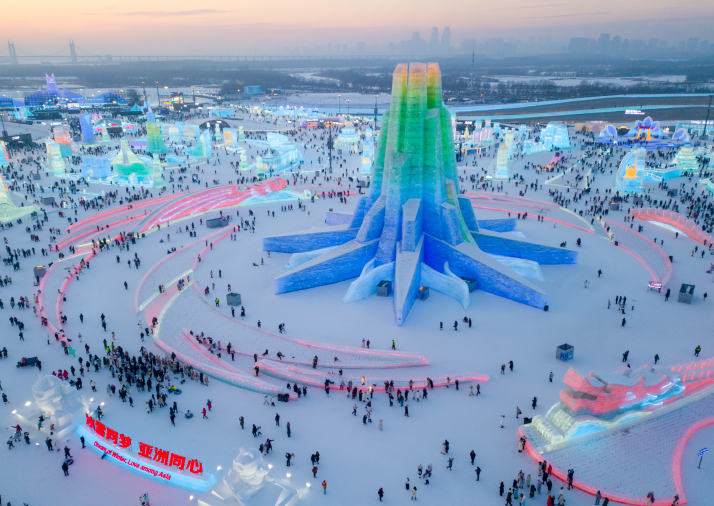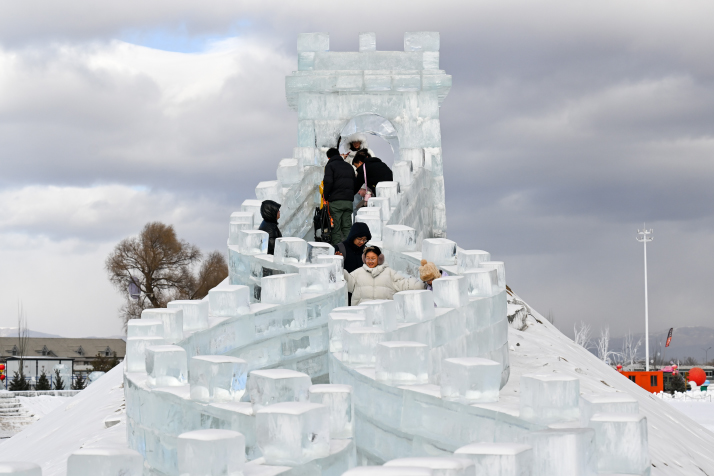| Business |
| Winter wonders create a flurry of excitement—and big bucks—in the tourism sector | |
|
|
 The Harbin Ice and Snow World, a well-known ice and snow theme park and one of China's most iconic winter attractions, in Harbin, Heilongjiang Province, buzzes with activity on January 5 (XINHUA)
After scrolling through numerous social media posts documenting ice and snow tourism activities, Sun Qi and her friends couldn't wait to visit the frosty city of Harbin in northeast China's Heilongjiang Province. After all, as a staff member at a university in Zhejiang Province, she has the opportunity to travel during the ongoing winter break. "It's a three-hour flight from Hangzhou to Harbin, where I will visit the Harbin Ice and Snow World," Sun told Beijing Review. She added that if her schedule wasn't packed, she would also travel to some destinations in the neighboring Jilin Province to enjoy the stunning beauty of the rime. The 29-year-old, who lives in east China, has always been fascinated by the winter wonders of north China's ice and snow scene. "The popularity of the ice and snow tourism continues to rise, driving overall consumption," according to a report released at the 2025 Ice and Snow Tourism Development Conference held in Harbin on January 5. The report stated that during the 2023-24 ice and snow season, which typically runs from November to March, 430 million people participated in ice and snow leisure tourism in China, generating a total revenue of 524.7 billion yuan ($71 billion). For the 2024-25 ice and snow season, the number of participants is expected to reach 520 million, with tourism revenue projected to exceed 630 billion yuan ($86 billion). A hot economy The Golden Latitude Zone of Ice and Snow in China refers to the region located between 35 and 50 degrees north. Due to its distinctive geographical and climatic characteristics, this vast land is abundant with high-quality ice and snow resources. Stretching from the northwest to the northeast, the zone encompasses Xinjiang Uygur and Inner Mongolia autonomous regions, Hebei Province, Beijing, and Liaoning, Jilin and Heilongjiang provinces. Collectively, these regions form what is known as the Smile Curve of China's ice and snow landscape, owing to the curved shape of the territory when viewed on a map. Each of these province-level regions has its exclusive features. For example, Hailar in Inner Mongolia, with its vast grasslands blanketed in snow during winter, offers an ice and snow prairie landscape. Visitors can enjoy activities such as horse-drawn sleigh rides and snowmobile excursions, providing an authentic experience of the northern frontier. Altay in Xinjiang, one of the historical origins of human skiing activities, beautifully combines ancient skiing traditions with modern ice and snow tourism, attracting ski enthusiasts from around the globe. Zhangjiakou in Hebei continues to shine as a prominent destination following its role as a venue for the Beijing 2022 Olympic and Paralympic Winter Games. Harbin is a major winter tourist destination in China. During the 2023-24 winter season, the city received over 87 million visits, up from 35 million in the 2019-20 season, with tourism revenue reaching 124.8 billion yuan ($17 billion), more than double the 60-billion-yuan ($8-billion) revenue recorded during the pre-pandemic season. The city's abundant ice and snow resources have contributed to the emergence of a "hot economy" in Harbin—and the broader northeast China region. The Ministry of Culture and Tourism (MCT) on December 16, 2024, recommended 12 winter tourism-themed travel routes across the country, aiming to further boost the ice and snow economy this season. The 12 routes are located across Beijing, Shanxi Province and Inner Mongolia in the north, Heilongjiang, Jilin and Liaoning in the northeast, Henan and Hubei provinces in central China, Chongqing Municipality and Sichuan Province in the southwest, as well as Shaanxi Province and Xinjiang in the northwest. The recommended routes feature winter sports venues, scenic spots, natural reserves, museums and special festive events, all designed to promote and expand tourism-related consumption in the ice and snow sector, according to the MCT.  Tourists visit an ice and snow park by the Daheihe River in Hohhot, north China's Inner Mongolia Autonomous Region, on January 7 (XINHUA)
Multiple measures The MCT also called on local tourism authorities to improve infrastructure and public services along the routes. In addition, tourism enterprises are encouraged to leverage folklore and regional features to optimize their products, in order to expand social and economic benefits. In response to this, different regions are implementing preferential policies to attract tourists and encourage participation in ice and snow activities. For example, Jilin has partnered with major local enterprises to distribute 100 million yuan ($13.6 million) in consumption vouchers to ice and snow aficionados nationwide. The province has also launched over 100 new bus routes dedicated to ice and snow tourism. In Xinjiang, Urumqi Diwopu International Airport in the regional capital of Urumqi has set up dedicated check-in counters for oversized luggage, making it easier for snow enthusiasts to transport their skiing equipment. Train K5197, running from Harbin to Yabuli South in Heilongjiang, has become the first train themed on ice and snow tourism under China Railway Harbin Group, going into operation on January 2. Passengers can take pictures across the train's differently themed cars. Yabuli Ski Resort is a national scenic spot and the largest ski resort in China, with Asia's longest ski trail and a host of skiing activities. Beijing's Miyun District also boasts rich winter tourism resources, featuring not one, but two major ski resorts—Nanshan and Yunfo. This makes it a popular destination for Beijing residents to hit the slopes in winter. This season, the district has launched a Tourism Plus Ice and Snow initiative, integrating skiing, hot springs, local specialty foods and ice and snow entertainment activities to create exclusive products and services. Tourists to the area can have their pick of full and all equally distinctive itineraries. Regions rich in ice and snow resources are also trying to attract more foreign tourists. For instance, several cooperation agreements were signed to boost Heilongjiang's ice and snow economy in Harbin on January 5, including an agreement between the Canberra Snow Projects Co. in Australia and Heilongjiang's Yabuli Mountain Resort, as well as a chartered flight cooperation agreement between Harbin Sightseeing International Travel Service and Thailand's Haoayou Travel Agency. China's Top 10 Destinations For Ice and Snow Tourism in 2025 Harbin, Heilongjiang Province Shenyang, Liaoning Province Changchun, Jilin Province Hulun Buir, Inner Mongolia Autonomous Region Zhangjiakou, Hebei Province Yanqing District, Beijing Mudanjiang, Heilongjiang Province Yichun, Heilongjiang Province Jilin, Jilin Province Altay, Xinjiang Uygur Autonomous Region (Source: 2025 Ice and Snow Tourism Development Conference on January 5) (Print Edition Title: Chill Out, Check In) Copyedited by Elsbeth van Paridon Comments to taoxing@cicgamericas.com |
|
||||||||||||||||||||||||||||||
|